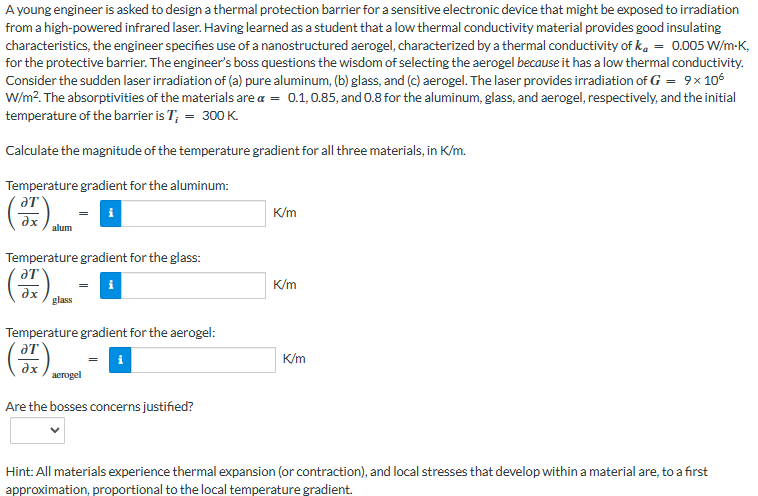A young engineer is asked to design a thermal protection barrier for a sensitive electronic device that might be exposed to irradiation from a high-powered infrared laser. Having learned as a student that a low thermal conductivity material provides good insulating characteristics, the engineer specifies use of a nanostructured aerogel, characterized by a thermal conductivity of k, = 0.005 W/m-K, for the protective barrier. The engineer's boss questions the wisdom of selecting the aerogel because it has a low thermal conductivity. Consider the sudden laser irradiation of (a) pure aluminum, (b) glass, and (c) aerogel. The laser provides irradiation of G = 9x106 W/m². The absorptivities of the materials are a = 0.1, 0.85, and 0.8 for the aluminum, glass, and aerogel, respectively, and the initial temperature of the barrier is T; = 300 K. Calculate the magnitude of the temperature gradient for all three materials, in K/m. Temperature gradient for the aluminum: ƏT dx alum Temperature gradient for the glass: (37) glass Temperature gradient for the aerogel: (57). aerogel Are the bosses concerns justified? K/m K/m K/m Hint: All materials experience thermal expansion (or contraction), and local stresses that develop within a material are, to a first approximation, proportional to the local temperature gradient.
A young engineer is asked to design a thermal protection barrier for a sensitive electronic device that might be exposed to irradiation from a high-powered infrared laser. Having learned as a student that a low thermal conductivity material provides good insulating characteristics, the engineer specifies use of a nanostructured aerogel, characterized by a thermal conductivity of k, = 0.005 W/m-K, for the protective barrier. The engineer's boss questions the wisdom of selecting the aerogel because it has a low thermal conductivity. Consider the sudden laser irradiation of (a) pure aluminum, (b) glass, and (c) aerogel. The laser provides irradiation of G = 9x106 W/m². The absorptivities of the materials are a = 0.1, 0.85, and 0.8 for the aluminum, glass, and aerogel, respectively, and the initial temperature of the barrier is T; = 300 K. Calculate the magnitude of the temperature gradient for all three materials, in K/m. Temperature gradient for the aluminum: ƏT dx alum Temperature gradient for the glass: (37) glass Temperature gradient for the aerogel: (57). aerogel Are the bosses concerns justified? K/m K/m K/m Hint: All materials experience thermal expansion (or contraction), and local stresses that develop within a material are, to a first approximation, proportional to the local temperature gradient.
Principles of Heat Transfer (Activate Learning with these NEW titles from Engineering!)
8th Edition
ISBN:9781305387102
Author:Kreith, Frank; Manglik, Raj M.
Publisher:Kreith, Frank; Manglik, Raj M.
Chapter2: Steady Heat Conduction
Section: Chapter Questions
Problem 2.11P
Related questions
Question
Thermal conductivity for pure aluminum: kal = 238 W/m⋅K ; Thermal conductivity for glass: kgl = 1.4 W/m⋅K.

Transcribed Image Text:A young engineer is asked to design a thermal protection barrier for a sensitive electronic device that might be exposed to irradiation
from a high-powered infrared laser. Having learned as a student that a low thermal conductivity material provides good insulating
characteristics, the engineer specifies use of a nanostructured aerogel, characterized by a thermal conductivity of k, = 0.005 W/m-K,
for the protective barrier. The engineer's boss questions the wisdom of selecting the aerogel because it has a low thermal conductivity.
Consider the sudden laser irradiation of (a) pure aluminum, (b) glass, and (c) aerogel. The laser provides irradiation of G = 9× 10²
W/m². The absorptivities of the materials are a = 0.1, 0.85, and 0.8 for the aluminum, glass, and aerogel, respectively, and the initial
temperature of the barrier is T; = 300 K.
Calculate the magnitude of the temperature gradient for all three materials, in K/m.
Temperature gradient for the aluminum:
(37)
dx
Temperature gradient for the glass:
dx
alum
glass
=
Temperature gradient for the aerogel:
(57).
aerogel
Are the bosses concerns justified?
K/m
K/m
K/m
Hint: All materials experience thermal expansion (or contraction), and local stresses that develop within a material are, to a first
approximation, proportional to the local temperature gradient.
Expert Solution
Step 1

Trending now
This is a popular solution!
Step by step
Solved in 3 steps with 3 images

Knowledge Booster
Learn more about
Need a deep-dive on the concept behind this application? Look no further. Learn more about this topic, mechanical-engineering and related others by exploring similar questions and additional content below.Recommended textbooks for you

Principles of Heat Transfer (Activate Learning wi…
Mechanical Engineering
ISBN:
9781305387102
Author:
Kreith, Frank; Manglik, Raj M.
Publisher:
Cengage Learning

Principles of Heat Transfer (Activate Learning wi…
Mechanical Engineering
ISBN:
9781305387102
Author:
Kreith, Frank; Manglik, Raj M.
Publisher:
Cengage Learning